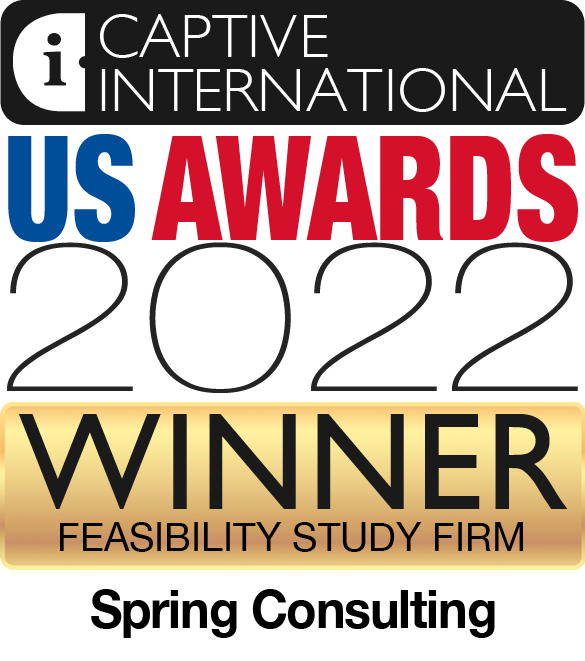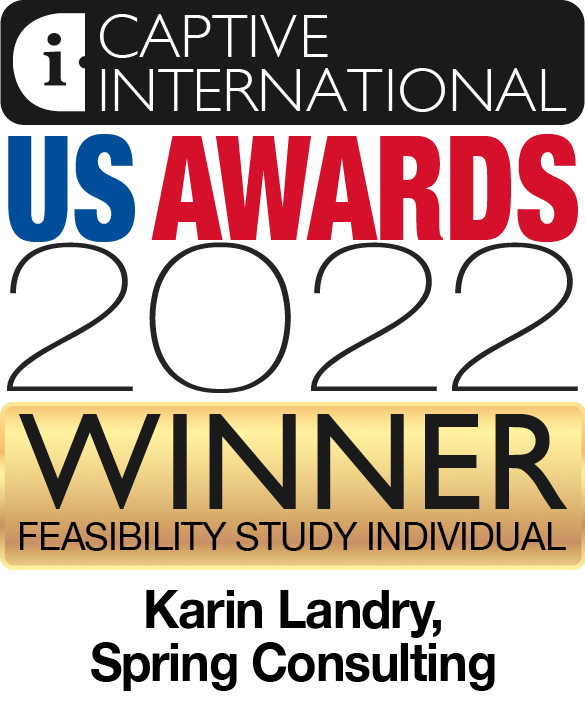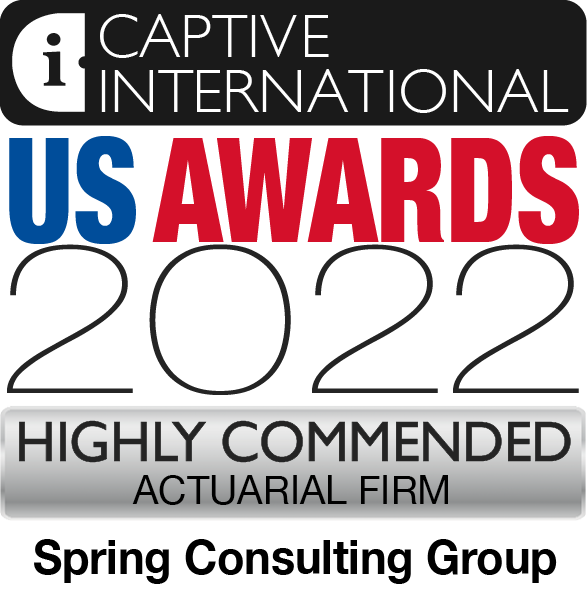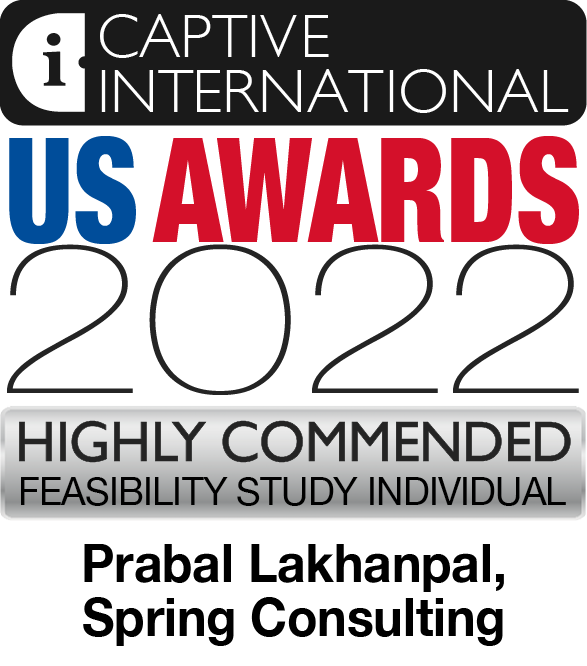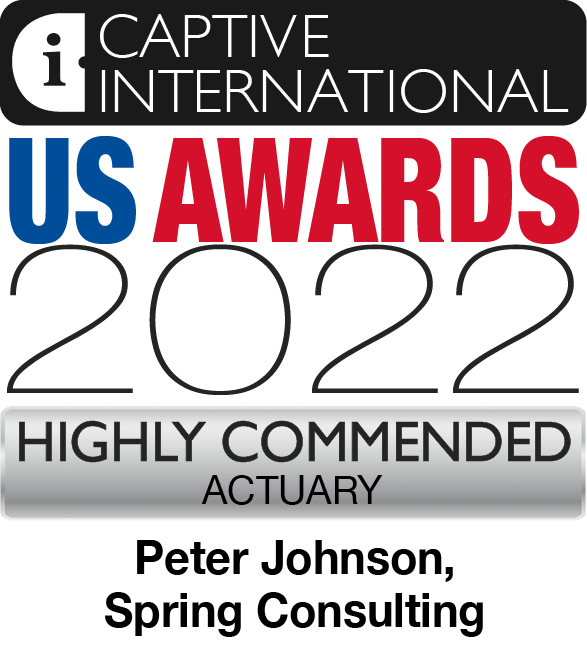What are the biggest trends or developments we should expect to see this year in the Property and Casualty (P&C) market?
Like many other industries, inflation has been top of mind for risk managers, insurers, and P&C professionals. McKinsey & Company estimated that inflation increased the cost of P&C claims by $30 billion in 2021,1 and it continues to be a primary concern across P&C lines. Property insurance is being hit hard this year. Hurricane Ian alone is expected to cost insurance companies over $60 billion.2 In combination with other recent catastrophic events (CATs) and construction cost inflation, this is driving substantial rate increases and higher underwriting standards for property policies. Inflation in auto costs and increased driving are also forcing insurers to respond with higher auto rates this year. So, cost-control practices will continue to be a main focus throughout 2023, both for insurers and businesses.
What impact is inflation having on the P&C market? Where is it hitting the hardest?
In the current hard market, we are expecting to see price increases across all lines of business, with an overall average increase of 9.3% in rates.1 Some of the top business lines being impacted include cyber, commercial property and personal lines/private risk (including private auto).
Following Hurricane Ian, we saw drastic increases in property insurance rates, with properties with poor risk quality seeing increases of 25% all the way up to 150% at the start of 2023.3 The number of natural disasters and level of exposure have been trending up over time, and costs are compounded by the need to rebuild with inflated prices and strained supply chains. According to NOAA National Center for Environmental Information, natural disasters cost the U.S. over $165 billion in 2022.4
When it comes to cyber, one of the toughest lines of business to write, we expect rates to increase as much as 50% for more complicated risks and 15% for simpler risks.1 This is less a result of inflation and more like growing pains for a newer market. As new risks continue to emerge and underwriting practices strengthen in cyber, it is difficult to predict how significantly inflation will influence costs.
Personal lines/private risk (including auto and homeowners insurance) rates are expected to increase almost 13% on average this year, with automobile rates seeing increases of 8-10% across the nation.1 Although Hurricane Ian and CATs dominated headlines in 2022, of the 15.5% increase in net losses across all business lines, private auto liability represented the largest sector in net incurred losses.5 Supply chain issues that drove up the prices for vehicle repairs and replacement had a direct impact on auto insurance claim severity and created a rate increase need for auto insurers to cover the cost increases. For many companies these rate increases are coming in conjunction with increased underwriting scrutiny, forced up retentions, and coverage reductions.
Workers’ Compensation is an exception to the norm this year. In spite of continued inflation, rates are expected to remain unchanged or slightly drop in 2023, with stable coverage options and underwriting practices. Employment Practices Liability is also looking favorable for buyers in 2023, with modest rate increases of 7% on average. Finally, Surety is also expected to see average increases just above 7%,1 but will face increased underwriting scrutiny with potential for larger rate changes on a case-by-case basis.
Geography is an important factor as well, and not just related to climate. For example, medical professional liability severity trends have increased, but this varies significantly by region. Some states are seeing double digit severity trends and rate increases while others are experiencing very modest increases. Differences in litigiousness and jury awards drive much of these state-by-state differences.
While most buyers are seeing rate increases and some reductions in coverage, high-risk clients are affected the most by continued inflation and other cost increases. This includes businesses with adverse loss histories, located in CAT-prone areas, or with frame construction buildings. Unfortunately, we are not seeing an influx of new players or investment to mitigate rising rates.
When looking at the industry level, Alera Group reports that the two sectors with the most unfavorable market situations are nonprofit organizations and the hospitality and gaming sector. Although nonprofits don’t make up a large portion of organizations in the U.S., they often require specialty insurers which can be costly and hard to find. Nonprofits are also often targets for cyberattacks and face unique underwriting processes that differ from other industries. The industry most impacted by inflation and unfavorable market conditions is the hospitality and casino industry where we expect to see increases in rates, reduced insurer options, and stricter underwriting processes across cyber, employment practices, general liability, property and umbrella.
In wake of recent natural disasters, what’s the outlook for property insurance underwriting and rates? On a practical level, what should buyers expect?
Property rates remain high and are expected to remain high for a while. Hurricane Ian caused big disruptions for property reinsurers, who in turn are pushing carriers for better valuation and stricter underwriting — especially in catastrophe-prone areas. As for how this will realistically play out, buyers may see fewer coverage options and new requirements like recent appraisals, insurance-to-value increases, engineering reports and complete applications. More underwriting processes will also focus on fire suppression systems, difficult-to-place risks and limits on high-rise structures.
According to Alera Group’s P&C Market Outlook, cyber liability pricing is expected to increase by 15% in 2023. What do you think this says about the market and what can organizations do to control their spend?
The cyber market is still relatively young and new risks can emerge quickly. Although rates are expected to increase by 15% on average for the simpler risks in 2023, more complicated cyber risks will see increases as much as 50%, often with difficult underwriting processes. Terms and conditions are changing to better clarify challenging coverages, resulting in longer underwriting processes. Employers and buyers of cyber insurance should ensure they are working with experienced underwriters and that they properly understand the specific cyber risks associated with their business so they can prioritize coverage selections.
Are there any emerging P&C lines that will take the spotlight in the years to come? What about in the captive space?
I cannot say for certain we will see completely new lines of business emerge in the next few years in the P&C market. But I do expect to see changes in coverage within different lines of business, particularly as our economy evolves and new technologies and products are utilized by both individuals and commercial industry. Artificial intelligence and other product innovations are expected to have an impact on both frequency and severity of loss outcome and will influence actuarial pricing indications for various insurance products.
I think captives will continue to emerge as a critical part of the ecosystem. As coverage capacity in lines like commercial property goes down or as new risks emerge in lines like cyber, captives offer organizations new options for layering the coverage they need at a price that truly reflects their own loss history and level of exposure. Captives are able to fill in the coverage gaps in cases where the commercial market has yet to come up with a competitive solution. This happened for cyber risks about a decade ago.
How are actuaries poised to help organizations and risk managers tackle some of the challenges mentioned?
Actuaries specialize in quantifying risks using statistics, whether for a business or an insurer or an entire industry and using that information to manage risks in a cost-effective way. This runs the gamut from reviewing a company’s loss history and current insurance policies to informing better choices in the commercial insurance market, all the way to setting up a captive insurance company tailored to the needs and experience of a specific business. In an environment like today with rising premiums and reductions in capacity and coverage options happening for many P&C lines, actuaries can provide organizations with tools and a higher level of confidence around managing their risks and their costs effectively. As an example, actuarial proforma financial models can be leveraged in a captive solution and aid a company’s decision-making around the appropriate balance between retaining risk and utilizing available market options to transfer risk in a cost-effective way.
The pandemic had certain influences on insurance underwriting. Have we transitioned past these pandemic issues yet?
Court room closures, significant reductions in vehicles on the road, delayed healthcare surgeries and procedures and other changes at the onset of the pandemic had a big impact on the underwriting experience of insurance companies for most property and casualty lines of business. As one would expect, when our economic engine slows the frequency of claims also does. As we are now well past these issues and our economy is mostly back up and running, we are now working through other, likely temporary issues that are currently impacting the underwriting experience within the commercial market and driving the need for rate increases. We are certainly seeing this in the auto insurance market. After over a decade of low treasury yields and a low inflationary environment, we are now in a high inflationary environment for personal lines auto. Supply chain issues during the pandemic resulted in significant increases in vehicle costs and have resulted in rising auto claim severities and the need for auto rate increases in the market.
Any final thoughts on the P&C landscape?
It’s a difficult year for property and auto costs, and cyber risks continue increasing. Some of the bottom-line impacts of these changes are unavoidable, but rate and coverage changes in the commercial insurance market are also driven by broad industry patterns that might not apply to a specific organization. I expect to see more businesses taking a close look at their own risk profile and exploring all of their options to close coverage gaps and take advantage of alternative risk funding structures when appropriate.
1 Alera Group’s 2023 P&C Market Outlook
2 https://wusfnews.wusf.usf.edu/economy-business/2022-12-01/hurricane-ian-is-expected-to-drive-more-property-insurers-out-of-business
3 https://www.businessinsurance.com/article/20230104/NEWS06/912354660/Some-rates-will-stabilize-less-optimal-risk-profiles-will-see-hikes-
4 https://www.climate.gov/news-features/blogs/2022-us-billion-dollar-weather-and-climate-disasters-historical-context
5 S&P Global Market Intelligence, March 2023
When it comes to Actuarial Services, many people are unclear what it entails. The video below breaks down how actuaries can help cut costs and optimize benefits plans.
Spring Consulting Group provides a wide range of Captive Services when it comes to the Employee Benefits and Property & Casualty (P&C) industries. In this Whitepaper, you can learn more about our captive services and how we approach captive implementation/optimization.
the International Foundation of Employee Benefit Plans recently wrapped-up their 32nd Annual Health Benefits + Conference Expo (HBCE) in Clearwater Beach, Florida. The conference brought together healthcare and benefits professionals from a range of industries to discuss leading topics and share expectations for the future. Having heard such positive feedback about the event, Spring was glad to attend, exhibit, and speak at the conference. Below are some of our biggest takeaways.
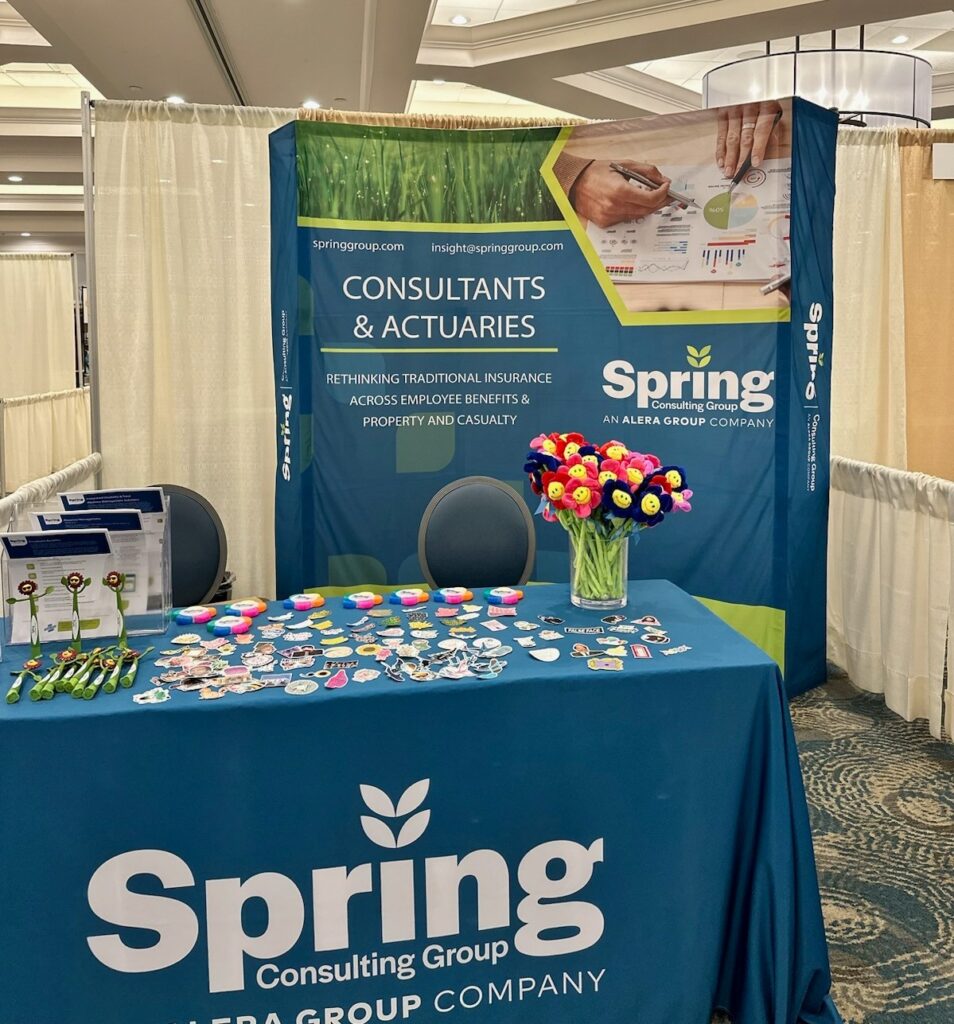
1) Pharmacy Cost Containment
This year there was a lot of talk surrounding the price of prescription drugs and tactics employers can adopt to help control costs without cutting benefits. There are many factors influencing the high costs of pharmacy drugs, some of which include chronic disease prevalence, the aging population and the growing volume of specialty medications. Below are some of the top sessions focused on controlling Rx costs.
– Representatives from Express Scripts explained the upsides to working with a Pharmacy Benefit Manger (PBM) and how they can help address pharmacy policies in their session titled, “How to Work With Your Pharmacy Benefit Manager.”
– The CEO and Co-Founder of TruDataRx, Cataline Gorla, discussed how comparative effectiveness research (CER) is being used by other countries to decide which drugs work best for specific medical conditions, and how self-insured employers can save money with said data.
2) Addressing Chronic Conditions
According to the Center for Disease Control (CDC), 90% of the nation’s healthcare spending goes towards people with chronic and mental health conditions1. As chronic diseases are very common among the American workforce, employers have started implementing specific benefits and policies to address common conditions, such as diabetes and obesity. Some of the sessions around this topic that we found most interesting include:
– Speakers representing the Nashville Public School System explained how they were able to introduce free resources such as telenutrition and fitness center access to help combat obesity and other health disparities.
– Dr. Mudita Upadhyaya from St. Jude Children’s Research Hospital presented on prevention strategies to address mental health and obesity in a pre- and post-COVID world; and why a mixed approach may be best.
– The Diabetes Leadership Council’s CEO, George J. Huntley spoke on diabetes and chronic disease risk management strategies, including medicines and technology that can help patients manage and prevent the disease.
3) The Future of Healthcare & Benefits
In recent years we have seen a great shift in the healthcare and benefits industry; we saw a great increase in telehealth, mental health resources, new/alternative types of paid leave, including sick leave and more. As we transition to a post-COVID world, we expect the evolution to continue. Below are some of the top trends professionals believe we will face in the coming years.
– Our Senior Vice President, Teri Weber, presented on market forces employers can utilize to meet future absence management challenges. Her session listed techniques employers can adopt to improve day-to-day administration of disability, absence and accommodations.
– In a session titled “Innovative Health Care Models—The Future of Direct Primary Care,” the presenter explained how many employers are changing to value-driving healthcare models to boost access and reduce costs.
– A session titled “Breaking the PTO Mold, Without Breaking the Bank,” reviewed how typical Paid Time Off (PTO) programs can be altered to better support employees’ well-being and financial health.
– The final session of the conference spotlighted how the pandemic has led to an increase in personal, economic and other stressors and has had a drastic impact on mental health, substance misuse and addiction. Attendees were informed on how they can implement workplace solutions that address these issues as well as identify warning signs.
The warmer weather was certainly a bonus, but the insights we gleaned and connections we made were what will keep us coming back to the HBCE conference. We want to thank IFEBP and our fellow colleagues who took the time to share their experience, stop by our booth, and make the energy so positive.
1https://www.cdc.gov/chronicdisease/about/costs/index.htm
Our Senior Vice President, Prabal Lakhanpal wrote an article for the Boston Business Journal on how employers can continue to provide strong benefit packages during a time of high inflation. You can find the full article here.
As seen on Alera Group’s Insights Page
In the cyclical market for Property and Casualty Insurance, we are more than a year into hard-market conditions, leading growing numbers of businesses to consider alternative risk funding. That, in turn, has created an abundance of work for insurance actuaries and Captive Insurance consultants.
OK, that’s a lot of insurance speak for one paragraph. Let’s unpack:
— A hard market for insurance is characterized by a rise in rates, a reduction in options for coverage, heightened scrutiny by policy underwriters and reduced carrier capacity for coverage limits. A combination of catastrophic weather events and so-called “nuclear verdicts” in liability lawsuits — as well as the cyclical nature of the Property and Casualty (P&C) Insurance market — were the driving forces behind the hardened conditions before the onset of COVID-19, and the pandemic exacerbated matters. Rate increases have leveled off to some extent in 2022, but, in general, most conditions in the market remain unfavorable to consumers.
— Alternative risk funding — also known as alternative risk financing or alternative risk transfer — is a mechanism for providing coverage by means other than commercial insurance. Types of alternative risk funding include Captive Insurance programs, in which a business or group of like businesses creates and funds its own private insurance company to cover one or more risks in the realms of both P&C and employee benefits. Workers’ Compensation, General Liability, Auto, Professional Liability and Medical Stop-Loss are the more common coverages to start with when insuring through a captive, but captives often expand into a funding mechanism for many of an organization’s other lines of insurance, including Cyber and Umbrella (also known as Excess Liability Insurance).
— Insurance actuaries use math, statistics and financial models to analyze the cost of risk and determine how much money a company should pay to protect itself against risk. All insurance carriers employ actuaries to help set policy premiums and limits. Some insurance agencies work with actuaries to negotiate policy details with carriers or, in a captive arrangement, to determine a premium that will cover claims and, in the long term, reduce the insured’s total cost of risk. Captives have the advantage of also building up retained earnings over time and allowing companies to take on more risk, generating additional insurance cost savings for the parent. Among multiple P&C capabilities, actuaries who work with or for an agency also educate clients on the cost of risk and how to manage it.
Now that we’ve cleared that up, let’s talk about the role of an actuary in managing the cost of risk and protecting your business with a customized insurance program — whether you’ve chosen to pursue alternative risk funding or not.
Why an Alternative Solution? And Why Now?
Business leaders know all too well about the hard market for Property and Casualty Insurance. Just as the pandemic began to wane early in 2022 and there were some signs of casualty rate increases leveling off, Russia’s invasion of Ukraine escalated supply-chain disruption and fuel shortages, accelerating the rise in economic inflation. Damage resulting from Hurricane Ian only made matters worse, of course, driving reinsurance — insurance for insurers — into what the Bank of America termed a “true hard market” of its own, with rising costs getting passed on to consumers. These issues have led to overall increases in U.S. P&C industry combined ratios over the past few quarters, sparking further rate increases for certain lines.
It’s no wonder more organizations are looking at captives and other alternative risk-funding solutions.
“Overall, between 2017 and 2021, captives added $4.3 billion to their year-end surplus while returning $5.8 billion in stockholder and policyholder dividends, representing $10.1 billion in insurance cost savings over purchasing coverage from commercial market third parties.”
“The number of U.S. captives continues to rise, although the growth of captive formations was tempered by the onset of economic uncertainty resulting from the pandemic, as well as ongoing scrutiny from the IRS and greater regulatory and reporting requirements.”
“However, these adverse conditions can serve to highlight the benefits of the captive segment and provide businesses an incentive to establish them,” said Fred Eslami, associate director, AM Best.
“‘This current environment allows captives to customize coverage for risks that may be uncommon or difficult to write or place in the standard market,’” Eslami said.
The growth in Captive Insurance has led to an increasing willingness on the part of carriers to work with captives and regard them as partners rather than threats, increasing options for captive solutions. And even if an organization in the end chooses to forgo alternative risk funding – either for an entire P&C program or for individual coverages, such as cyber or commercial umbrella – simply exploring an alternative and having it as an option can improve its position in the insurance market.
Actuary Capabilities: Your Data, Your Future
For insurance agents and brokers, designing an insurance program tailored to your industry and company is as much art as it is science. Working with an actuary enables you to incorporate greater amounts of empirical evidence into evaluating risks and determining insurance solutions: Here’s what the numbers demonstrate about your situation now, and here’s what our analysis shows about how you’ll perform using this solution.
While any good broker will work to design an insurance program customized for your business, a broker working with an actuary will be especially well-equipped to design a solution tailored to your unique needs and goals. Among the key issues an actuary can help brokers work through are:
- Determining appropriate retention/deductible levels to help the client reduce the total cost of risk;
- Estimating client retained unpaid claims liabilities at quarter/year-end;
- Estimating carrier letter-of-credit need for a large deductible program;
- Estimating possible retained loss outcomes at various confidence levels;
- Performing a captive feasibility study.
Many brokers work in silos, taking a vertical approach in evaluating risk based on industry. Actuaries generally don’t distinguish by industry; they analyze across various industries, focusing on each individual client’s loss history (including frequency and severity), claim status, policy details, exposures and risk-control program before determining financial projections for the organization. Taking the long-term view allows for consideration of fluctuations in company and market performance over a period of time, and increases the likelihood of long-term savings and profits.
Optimizing Your Insurance and Benefits Solutions
As companies grow, they generally reach a point where their claims experience is predictable across one or more lines of coverage. Able to determine such predictability, an actuary can then help you:
- Minimize your total insurance spend, directing more money to the coverage your business needs the most.
- Reduce spending on the risks you have under control. This is where alternative risk funding becomes viable.
If you’ve reached the point where your business is paying, say, $100,000 to $250,000 in annual premium, a group captive might be the best solution because you probably aren’t yet structured appropriately to meet the insurance tests required to form a single-parent captive and the economies of scale may not be there for a single-parent captive solution. In such a case you may need to diversify your risk with other organizations (heterogeneous or homogeneous) — in a group captive or in a shared-risk pool solution utilizing reinsurance — for at least the time being.
The bigger, more complex, more diversified a company becomes, the more a fully funded, single-parent captive emerges as an optimal solution in which the business is insuring only its own risk. A single-parent captive also allows for more coverage flexibility and transparency than a group captive program. Quite often, both benefits and P&C risks are insured by a single-parent captive.
What drives the decision to move from traditional, carrier-based insurance to a captive program is savings and, ultimately, return on investment (ROI). How? By moving expenditures that create carrier profits into the captive solution. Captives are highly efficient, with very low expense ratios, unlike carriers. Free from providing a carrier with underwriting income and investment income on held reserves, you’re able to retain this income to ultimately generate a profit and facilitate an insurance mechanism that competes with the commercial market.
An Organization-Focused Approach
In taking an organization-focused approach toward financial analysis, actuaries look not only at funding for Property and Casualty Insurance but also at spending on employee benefits. Most captive insureds will see annual savings between 10% and 40% for premiums that flow through a captive instead of the commercial market.
As we approach the end of the year, Alera Group invites you to the final event in our 2022 Engage series of employee benefits webinars, A Look Ahead to 2023: Hot Topics and Trends. Join us on Thursday, December 15 as we discuss benefits financial officers and HR professionals need to think about now — including alternative solutions — as they plan for the year ahead.
ACCESS ALERA’S WEBINAR HERE
Our Actuarial Team teamed up with Alera Group experts on this COVID-19 and Mental Health Trends whitepaper which looks at the post-pandemic mental health landscape, including impacts on employees, children, plan costs, care gaps, and substance abuse.
In collaboration with Alera Group, our Actuarial Team helped create a whitepaper which provides guidance around eligibility, procedures, and plan costs for coverage of over-the counter COVID-19 tests within health plans, as mandated by President Biden. You can find the full whitepaper here.
Captive International has released the winners for the 2022 US Awards. Spring is proud to announce that our company and our Managing Partner, Karin Landry were selected as winners for Best Feasibility Study Firm and Best Feasibility Study Individual (respectively). We were also highly commended for Best Actuarial Firm, Best Individual Feasibility Study (Prabal Lakhanpal) and Best Actuary (Peter Johnson).
